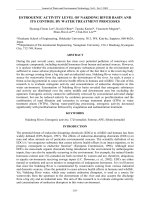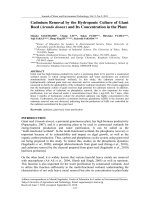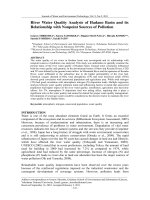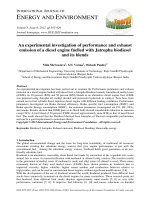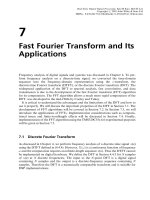CHEMISTRY AND ITS BRANCHES
Bạn đang xem bản rút gọn của tài liệu. Xem và tải ngay bản đầy đủ của tài liệu tại đây (307.39 KB, 20 trang )
8
UNIT 1 : CHEMISTRY AND ITS BRANCHES
Chemistry is the science of substances - of their structure, their properties, and the reactions that
change them into other substances.
The study of chemistry may be divided into the following branches:
- General chemistry, which is an introduction to the entire science.
- Qualitative analysis, giving the methods of testing for the presence of chemical substances.
- Quantitative analysis, giving the methods of accurate determination of the amounts of different
substances present in a sample of material.
- Inorganic chemistry, which is the chemistry of elements other than carbon, and their compounds.
- Organic chemistry, which is the chemistry of the compounds of carbon.
- Physical chemistry, which studies the quantitative relations among the properties of substances and
their reactions.
- Biochemistry, which is the chemistry of the substances comprising living organisms.
- Structural chemistry, which deals with the molecular structure and its relation to the properties of
substances.
- Radiochemistry, which is the chemistry of radioactive elements and of reactions involving the
nuclei of atoms.
- Industrial chemistry, which is concerned with industrial processes.
Although chemistry is a very large and complex subject, which still continues to grow as new
elements are discovered or made, new compounds are synthesized, and new principles are formulated.
The chemists or chemical engineers need to have some knowledge of all its branches, even if he may be
specialized in a particular line.
Chemistry science cannot do without physics and mathematics, and is also closely linked to some
other sciences, e.g. inorganic chemistry is linked closely to geology, mineralogy, and metallurgy, while
organic chemistry is linked to biology in general.
EXERCISES
A. Read and translate into Vietnamese
substances, reaction, chemistry, analysis, method, determination, material, inorganic, element, compound,
organic, biochemistry, organism, molecular, radioactive, nuclei, industrial, atom, processes, synthesized,
engineer, specialized, particular, accurate, mathematics, closely, geology, mineralogy, metallurgy,
comprise, biology, concerned, knowledge, continue, sample
B. Answer the following questions
1. Give the definition of chemistry.
2. Which are the main branches of chemistry?
3. What is the difference between qualitative and quantitative analysis?
4. What is the difference between inorganic and organic chemistry?
5. What does physical chemistry study?
6. What does structural chemistry deal with?
7. What is radiochemistry?
8. Which branches of chemistry are you interested in?
9. Is it necessary for you to have some knowledge of all branches of chemistry?
10. Can chemistry as a science do without physics and mathematics?
C. Translate into English
1. Hóa học là khoa học về vật chất riêng biệt.
2. Hóa học được chia thành những ngành nào?
3. Toán học là khoa học về số, còn vật lí nghiên cứu ánh sáng và nhiệt.
4. Hóa học công nghiệp quan tâm đến gì?
9
UNIT 2 : HYDROGEN
Hydrogen, the first element in the periodic table, is a very widely distributed element. Its most
important compound is water, H
2
O. Hydrogen is found in most of substances, which constitute living
matter: sugar, starch, fats, and proteins. It occurs in petroleum, petrol, and other hydrocarbon mixtures. It
is also contained in all acids and alkalis. There are more compounds of hydrogen known than of any other
element.
Pure hydrogen is a colorless, odorless, tasteless gas. It is the lightest of all gases, density being
about 1/14 that of air, viz. 0.08987 gm.per liter. It does not support respiration, but is not poisonous.
Hydrogen is a good conductor of heat as compared with other gases. Its specific heat is also higher than
most other gases.
Hydrogen is a combustible gas, burning in air or oxygen with a nearly colorless flame to form
water vapor. Hydrogen also readily combines with fluorine and chlorine, less readily with bromine,
iodine, sulfur, phosphorus, nitrogen, and carbon.
The element is made commercially by the electrolysis of water, and is used in large quantities in
the manufacture of ammonia, in the hydrogenation of liquid fats to form solid fats, and in the production
of high temperatures.
In the laboratory hydrogen may be easily prepared by the reaction of an acid as sulfuric acid, with a
metal such as zinc:
H
2
SO
4
+ Zn = H
2
+ ZnSO
4
Hydrogen may be set free also by the action of certain metals on water. Thus sodium and potassium
react with cold water, producing sodium hydroxide and hydrogen. Boiling water may be readily
decomposed by ordinary magnesium powder, while steam is decomposed by heated magnesium, zinc,
iron, cobalt, lead, tin, and nickel, but not by silver or copper.
Hydrogen is evolved by the action of zinc, magnesium and iron on dilute hydrochloric and sulfuric
acid on aluminum and tin.
A solution of caustic soda or potash readily dissolves zinc or aluminum on warming, with evolution
of hydrogen and formation of a soluble zincate or aluminate.
EXERCISES
A. Read and translate into Vietnamese
hydrogen, periodic, distributed, water, constitute, proteins, petroleum, petrol, hydrocarbon, alkalis, gases,
density, combustible, oxygen, vapor, readily, combine, fluorine, chlorine, bromine, iodine, nitrogen,
sulfur, electrolysis, ammonia, hydrogenation, liquid, production, laboratory, sulfuric acid, zinc, sodium,
potassium, hydroxide, decompose, magnesium, iron, cobalt, lead, tin, nickel, copper, dilute, concentrated,
hydrochloric acid, aluminum, solution, caustic, potash, dissolve, evolution, soluble, zincate, aluminate.
B. Answer the following questions
1. Where does hydrogen occur?
2. What are the properties of hydrogen?
3. What elements does hydrogen/ less/ readily combine with?
4. How can hydrogen be prepared?
5. What are its uses? Say a few sentences about hydrogen.
C. Translate into English
1. Hydro là chất khí không màu, là thành phần chủ yếu cấu tạo nên nước.
2. Trong tự nhiên hydro không tồn tại ở trạng thái tự do, nhưng tồn tại rất nhiều hợp chất hydro.
3. Hydro là một chất rất quan trọng cho công nghiệp hóa học, nó được sử dụng rất nhiều trong quá
trình sản xuất như: sản xuất muối amôn, quá trình hydrogen hóa dầu thành mỡ.
10
UNIT 3 : WATER
Water is one of the most important of all chemical substances. It is the chief constituent of living
matter. Its physical properties are strikingly different from those of other substances.
Ordinary water is impure, it usually contains dissolved salts and dissolved gases, and sometimes
organic matter. For chemical work water is purified by distillation. Pure tin vessels and pipes are often
used for storing and transporting distilled water. Glass vessels are not satisfactory, because the alkaline
constituents of glass slowly dissolve in water. Distilling apparatus and vessels made of fused silica are
used in making very pure water. The impurity, which is hardest to keep out of water, is carbon dioxide,
which dissolves readily from the air.
The physical properties of water. Water is a clear, transparent liquid, colorless in thin layers. Thick
layers of water have a bluish-green color. Pure water freezes at 0
o
C, and boils at 100
o
C. These
temperatures are means of identifying water, for no other substance has these freezing and boiling points.
The physical properties of water are used to define many physical constants and units. The unit of
mass in the metric system is chosen so that 1 cm
3
of water at 4
o
C/ the temperature of its maximum
density/ weighs 1.00000 gram. A similar relation holds in the English system: 1 cu. Ft. of water weighs
approximately 1,000 ounces.
Steam and ice
Steam is water in the gaseous state. A cubic inch of water gives about a cubic foot of steam.
When gaseous water is mixed with other gases, as in the air, we speak of it as water vapor; when
unmixed, we call it steam. Water may exist as steam at temperature lower than 100
o
C, provided the
pressure is less than the usual atmospheric pressure of 15 pounds per square inch.
If water is cooled sufficiently, it solidifies at 0
0
C to ice. There is considerable expansion during
the solidification, and consequently ice is lighter than an equal volume of water.
If we apply heat to ice, it melts. The water that runs off the melting ice is at a temperature of 0
0
C,
the same temperature as the ice.
EXERCISES
A. Read and translate into Vietnamese
constituent, properties, strikingly, ordinary, impure, contain, purified, distillation, pure, vessel, pipe,
distilled, alkaline, apparatus, fused, silica, impurity, carbon dioxide, air, transparent, bluish-green,
identify, temperature, define, unit, weigh, approximately, ounce, gaseous, cubic, inch, pressure,
atmospheric, square, sufficiently, equal, volume, ice, steam.
B. Answer the following questions
1. Why is water important to a human beings?
2. What are the characteristic properties of water?
3. Are glass vessels satisfactory for storing and transporting distilled water?
4. Where does carbon dioxide readily dissolve from?
5. What is the color of water?
6. How is the unit of mass in the metric system chosen?
7. What is steam?
8. What is the difference between steam and vapor?
9. What is ice?
C. Translate into English
1. Nước bình thường là một chất không tinh khiết, bao gồm các hợp chất khác nhau, vì vậy nó được
tinh chế bằng chưng cất.
2. Điểm sôi và điểm đóng băng là những tính chất đặc trưng của nước, và được sử dụng để xác định
nó.
3. Nước đóng băng được gọi là nước đá.
4. Nếu chúng ta đem đun sôi nứơc lên trên 100
0
C, nó biến thành hơi.
11
UNIT 4 : CLASSIFICATION OF MATTER
Different materials may be distinguished by their properties, the most obvious of which is the
physical state, or state of aggregation, on the basis of which all materials are classified as solids, liquids,
and gases.
The characteristic feature of gas is that its molecules are not held together, but move about freely.
Because of this freedom of molecular motion a gas does not possess either definite shape or definite size,
it shapes itself to its container. A liquid, on the other hand, has a definite volume, but does not have a
definite shape. Only a solid is characterized both by a definite shape and definite size.
By the word substance a chemist means an essentially pure substance/ Actually, all substances are
more or less impure/ When referring to very impure substances, solutions, and mixtures, the word
material should be used instead.
All substances can be divided into two classes: elementary substances and compounds. An
elementary substance is a substance, which consists of atoms of only one kind, a compound is a substance
which consists of atoms of two or more different kinds. These atoms of two or more different kinds must
be present in a definite numerical ratio since substances are defined as having a definite invariant
composition. Thus an elementary substance is composed of two or more elements./To avoid confusion, it
is necessary for us to state exactly what a particular kind or atom in the above definition of an element
means. By this expression we mean an atom whose nucleus has a given electrical charge. All nuclei have
positive electrical charges which are equal to or integral multiples of the charges of the electron/ with an
opposite sign./The integer which expresses this relation is called the atomic number.
The word mixture is used to refer to a homogeneous material/ exhibiting a uniform structure/,
which is not a pure substance, or to a heterogeneous aggregate of two or more substances. The ingredients
of a mixture are called its component. Sometimes a mixture consisting mainly of one component, with
much smaller amounts of others, is called an impure substance. The components present in the smaller
amounts are called impurities.
EXERCISES
A. Read and translate into Vietnamese
distinguished, aggregation, basis, characteristic, molecule, motion, possess, definite, container,
characterized, essentially, actually, mixture, elementary, consist, numerical, ratio, invariant, composition,
compose, confusion, expression, nucleus, electrical charge, equal, integral, integer, electron, changed,
sign, relation, atomic, refer, homogeneous, exhibit, uniform, heterogeneous, aggregate, ingredient,
component, amount.
B. Answer the following questions
1. Which are the three physical states?
2. Give the characteristic features of a gas, a liquid, and a solid.
3. What is a substance in chemistry?
4. What is the difference between an element and a compound?
5. What is the mixture? Say a few sentences about the classification of matter.
C. Translate into English
1. Các chất rắn, chất lỏng và chất khí được phân biệt dựa trên cơ sở trạng thái vật lí của nó.
2. Các chất khí không có hình dạng và kích thước nhất định, trong khi đó chất rắn được đặc trưng
bằng hình dáng và kích thước nhất định.
3. Chúng ta hiểu cấu tạo vật chất từ nguyên tử như thế nào?
4. Các thành phần riêng biệt của hỗn hợp có thể được tách ra b
ằng các phương pháp khác nhau.
12
UNIT 5 : SOLUTIONS
If sugar and water, two pure substances, are mixed together, a solution result, uniform throughout
in its properties, in which the sugar can neither be seen with a microscope nor filtered out. It is not
distinguishable from a pure substance in appearance.
The experimental distinction between a pure substance and solution is quite simple when the solute
/the dissolved substance/ is not volatile so that it is left behind when the solvent is evaporated. However,
when both are volatile the matter is not quite so simple and it is necessary to find out whether any change
in composition and hence in properties occurs during a change in state.
Suppose we wish to determine whether air is a pure substance or a solution. One method would be
to liquefy a certain amount and then observe what happens to it as it slowly evaporates. As the
evaporation proceeds one may observe that
a- The light blue color gradually becomes deeper
b- The temperature of the liquid slowly rises
c- The densities of both liquid and gas change.
Any one of these as well as other possible observations show that air must contain two or more
components whose relative amounts change during the evaporation, causing the observed changes in
properties due to differences between the components in color, volatility, density, chemical behavior. Still
other properties might have been used.
The term solution is not restricted to liquid solutions. All gases are completely miscible with each
other, forming but one phase, so that every mixture of gases is a solution. Alloys of silver and gold, no
matter what the relative amounts of the two metals, contain but one kind of crystal,/the properties of
which change continuously with the composition/, thus being a solid solution.
If liquid air is distilled in a scientifically constructed still, it is possible to separate it into two nearly
pure constituents. One of these constituents, nitrogen, is found to be slightly lighter than air; it can be
condensed to a colorless liquid boiling at -194
0
C; it is very inert chemically, reacting with but few other
substances. The other constituent, oxygen, is slightly heavier than air; it gives, when condensed at low
temperatures, a blue liquid boiling at -182.5
0
C, and it reacts readily with many substances.
As another illustration, suppose we have a solid metal, which appears to be perfectly homogeneous
under the microscope. We could determine whether it is a solution or a pure substance by melting it,
dipping into the melt a suitable thermometer and letting it cool slowly, taking temperature readings at
regular intervals, and plotting temperature against time.
EXERCISES
A. Read and translate into Vietnamese
result, throughout, microscope, appearance, experimental, distinction, solute, volatile, solvent, evaporated, matter,
occur, determine, liquefy, observe, evaporation, proceed, gradually, observation, relative, cause, changes,
volatility, behavior, restricted, miscible, completely, phase, alloy, metal, continuously, solid, scientifically,
constructed, separated, condensed inert, react, illustration, suppose, appear, perfectly, suitable, thermometer,
interval.
B. Answer the following questions
1. What is a solution?
2. Is it distinguishable from a pure substance in appearance?
3. When is the experimental distinction between a pure substance and a solution simple?
4. What is the difference between a solute and a solvent?
5. How can you determine whether air is a pure substance or a solution?
6. Is the term solution restricted only to liquid solutions?
7. What does it mean when a substance is volatile?
8. Give the constituents of air and compare them with each other.
9. Give some liquids that are miscible.
10. Give some examples of solids soluble in liquids.
13
C. Translate into English
1. Nếu chúng ta đun nóng một dung dịch, chúng ta có thể quan sát thấy những thay đổi khác nhau của
chúng.
2. Tất cả những sự thay đổi xảy ra là do những tính chất khác biệt của dung môi và chất hoà tan. Ví
dụ: dung dịch Na
2
CO
3
trong chất lỏng có được là do CO
2
hoà tan trong nước dưới áp suất và nhiệt
độ.
3. Chất dễ bay hơi là chất dễ dàng biến thành hơi ở nhiệt độ thường.
UNIT 6 : ISOLATION AND PURIFICATION OF SUBSTANCE
Practical chemistry includes many special techniques for the isolation and purification of
substances. Some substances occur very nearly pure in nature, but most materials are mixtures, which
must be separated or purified if pure substances are desired, and most manufactured materials also require
purification.
The separation of two different phases is often rather easy. Particles of a solid phase mixed with a
liquid phase may be separated from the liquid by filtration. Often the solid is present because it has been
produced from solution in the liquid by a chemical reaction or by change in conditions/such as by
cooling/ the solid is then called the precipitate. The precipitate is removed by pouring the mixture on a
folded filter paper in a funnel. The liquid/ called the filtrate/ runs through, and the grains of precipitate/
the residue/ are retained, unless they are too small. Ordinary filter paper contains pores about 0.001cm in
diameter, and smaller particles pass through.
A precipitate may also be removed by letting the suspension stand quietly until the precipitate has
settled to the bottom of the container under the influence of gravity. The supernatant liquid can then be
poured off. This process of pouring off is called decantation.
The process of settling can be accelerated by the use of centrifugal force, in a centrifuge. Ordinary
centrifuges produce forces of the order of 100 or 1,000 times that of gravity. Supercentrifuges have been built
which give forces over 100,000 times as great as that of gravity.
Two liquid phases may be conveniently separated by use of a special device, the separatory funnel.
A dropper may also be used for this purpose.
An impure substance may often be purified by fractional freezing. The impure liquid substance is
cooled until part of it has crystallized, and the remaining liquid, which usually contains most of the
impurities, is then poured off, leaving the purified crystals.
A liquid can be purified by distillation in a still. The liquid is boiled in a flask or some other
container, and the vapor is condenser, forming a liquid distillate, which is collected in a receiver. The first
portions/fractions/ of the distillate tend to contain the more volatile impurities, and the residue in the flask
tends to retain the less volatile ones. Stills so special design have been invented, which are very effective
in separating liquid mixtures into their components.
EXERCISES
A. Read and translate into Vietnamese
isolation, purification, include, technique, desire, manufacture, require, separation, particle, filtration,
precipitate, removed, pour, funnel, filtrate, residue, retained, pore, diameter, suspension, influence,
gravity, supernatant, decantation, accelerated, use, used, centrifugal, centrifuge, produce, conveniently,
device, separatory, purpose, fractional, crystallized, crystal, distillation, condenser, distillate, collected,
receiver, design, effective
B. Answer the following questions
1. Which methods can be used for purifying substances?
2. What is decantation?
3. How can the process of settling be accelerated?
4. What is a separatory funnel used for?
5. What does a still consist of?
6. Say a few sentences about the isolation and purification of substances.
14
C. Translate into English
1. Trong tự nhiên thường chỉ tồn tại rất ít các chất tinh khiết, phần lớn các chất tự nhiên phải được tinh chế
bằng phương pháp nào đó.
2. Có rất nhiều phương pháp khác nhau để tinh chế vật chất và tách nó ra khỏi hỗn hợp.
3. Để tách chất rắn khỏi chất lỏng, người ta sử dụng phương pháp lọc hay lắng gạn.
4. Chúng ta hiểu quá trình lắng gạn là quá trình chấ
t lỏng tự lắng chất kết lắng xuống đáy bình chứa.
UNIT 7 : THE RATE OF CHEMICAL REACTIONS
Every chemical reaction requires some time for its completion, but some reactions are very fast and
others very slow. Reactions between ions in solution without change in oxidation state are usually
extremely fast. An example is the neutralization of an acid by a base, which proceeds as fast as the
solutions can be mixed. Presumable nearly every time a hydronium ion collides with a hydroxide ion
reaction occurs, and the number of collisions is very great, so that there is little delay in the reaction. The
formation of a precipitate, such as that of silver chloride when a solution containing silver ion is mixed
with a solution containing chloride ion, may require a few seconds, to permit the ions to diffuse together
to form the crystalline grains of the precipitate. On the other hand, ionic oxidation-reduction reactions are
sometimes very slow. An example is the oxidation of stannous ion by ferric ion. This reaction does not
occur every time a stannous ion collides with one or two ferric ions. In order for the reaction to take
place, the collision must be of such a nature that electrons can be transferred from one ion to another, and
collisions, which permit this electron transfer to occur, may be rare.
The factors, which determine the rate of a reaction, are manifold. The rate depends not only upon
the composition of the reacting substances, but also upon their physical form, the intimacy of their
mixture, the temperature and pressure, the concentrations of the reactants, special physical circumstances
such as irradiation with visible light, ultraviolet light, X-rays, neutrons, or other waves or particles, and
the presence of other substances which affect the reaction but are not changed by it/catalysts/.
Most actual chemical processes are very complicated, and the analysis of their rate is very difficult.
As reaction proceeds the reacting substances are used up and new ones are formed; the temperature of the
system is changed by the heat evolved or absorbed by the reaction; and other effects may occur which
influence the reaction in a complex way. For example, when a drop of a solution of potassium
permanganate is added to a solution containing hydrogen peroxide and sulfuric acid no detectable
reaction may occur for several minutes. The reaction speeds up, and finally the rate may become so great
as to decolorize a steady steam of permanganate solution as rapidly as it is poured into the reducing
solution. This effect of the speeding up of the reaction is due to the vigorous catalytic action of the
products of permanganate ion reduction: the reaction is rapidly accelerated as soon as they are formed.
EXERCISES
A. Read and translate into Vietnamese
require, completion, oxidation, extremely, neutralization, base, presumably, nearly, hydronium ions,
collide, collision, delay, formation, chloride, permit, diffuse, crystalline, reduction, oxidation, stannous,
transfer, manifold, depend, intimacy, concentration, reactant, circumstances, irradiation, ultraviolet,
neutron, affect, effect, catalyst, evolved, absorbed, permanganate, detectable, decolorize, reduce,
vigorous, product.
B. Answer the following questions
1. What is meant by the rate of a chemical reaction?
2. Name some factors affecting the rate of a chemical reaction.
3. What is the effect of temperature and pressure on reaction rate?
4. What is the function of catalysts?
5. What is the rate of complicated chemical processes?
6. Say a few sentences about the rate of chemical reactions.
15
C. Translate into English
1. Tốc độ của phản ứng hóa học là thời gian cần thiết để kết thúc phản ứng đó.
2. Tốc độ của phản ứng hóa học phụ thuộc vào thành phần của chất tham gia phản ứng và rất nhiều
yếu tố khác.
3. Nhiệt độ cũng như áp suất có thể ảnh hưởng đáng kể đến quá trình xảy ra phản ứng.
4.
Chất xúc tác là chất làm tăng nhanh phản ứng hóa học nhưng nó không tham gia trực tiếp vào phản
ứng. Để dễ dàng thực hiện phản ứng hóa học, hỗn hợp phản ứng phải được đun nóng lên đến một
nhiệt độ nhất định.
UNIT 8
:
HYDROCARBONS
Hydrocarbons are compounds containing only carbon and hydrogen atoms. The simplest
hydrocarbon is methane, CH
4
. Its molecules are tetrahedral, the four hydrogen atoms lying at the corners
of a regular tetrahedron around the carbon atom, and connected with the carbon atom with single bonds.
Methane is a gas, which occurs in natural gas, and is used as a fuel. It is also used in large quantities for
the manufacture of carbon black, by combustion with a limited supply of air. The hydrogen burn to water,
and the carbon is deposited as very finely divided carbon, which finds extensive use as filler for rubber
for automobile tires.
Methane is the first member of a series of hydrocarbons having the general formula C
n
H
2n+2
, called
the methane series or paraffin series. The compounds of this series are not very reactive chemically. They
occur in complex mixtures called petroleum. The molecules heavier than ethane are characterized by
containing carbon atoms attached to one another by single bonds. The lighter members of the paraffin
series are gases, the intermediate members are liquids, and the heavier members are solid or semi-solid
substances. Gasoline is the heptane-nonane mixture, and kerosene the decane-hexadecane mixture. Heavy
fuel oil is a mixture of paraffins containing twenty or more atoms per molecule. The lubricating oils and
solid paraffin are mixtures of still larger paraffin molecules.
The substance ethylene, C
2
H
4
, consists of molecules in which there is a double bond between the
two carbon atoms. This double bond confers upon the molecule the property of much greater chemical
reactivity than is possessed by the paraffins. Because of this property of readily combining with other
substances, ethylene and related hydrocarbons are said to be unsaturated.
Acetylene is the first member of a series of hydrocarbons containing triple bonds. Aside from
acetylene, these substances have not found wide use, except for the manufacture of other chemicals.
The hydrocarbons, the molecules of which contain a ring of carbon atoms, are called cyclic
hydrocarbons. Cyclohexane, C
6
H
12
, is representative of this class of substances. It is a volatile liquid,
closely similar to normal hexane in its properties.
Another important hydrocarbon is benzene, having the formula C
6
H
6
. It is a volatile liquid/ b.p.
80
0
C/, which has an aromatic odor. For many years there was discussion about the structure of the
benzene molecule. August Kekule suggested that the six carbon atoms are in the form of a ring, and this
has been verified: diffraction studies have shown that the six atoms form a regular planar hexagon in
space, the six hydrogen atoms being bonded to the carbon atoms, and forming a larger hexagon. Kekule
suggested that, in order for a carbon atom to show its normal quadrivalence, the ring contains three single
bonds and three double bonds in alternate positions. Other hydrocarbons, derivatives of benzene, can be
obtained by replacing the hydrogen atoms by methyl groups or similar groups. Benzene and its
derivatives are used in the manufacture of drugs, explosives, photographic developers, plastics, synthetic
dyes, and many other substances.

